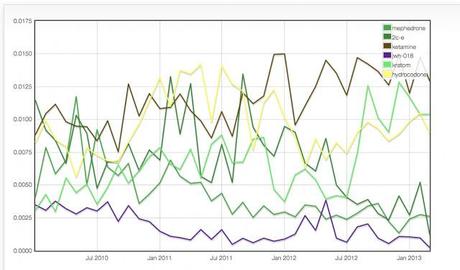Some number crunching at bluelight.ru.

A fantastic set of interactive graphics tracking conversational trends in drugs at the chat board bluelight.ru reveals some surprises, to the delight of data journalists everywhere. Virostatiq, a software package authored by Marko Plahuta, was put to the task of analyzing traffic at the drug discussion site. Various kinds of plots are available, with endless variables to permutate. Bear in mind that the data that got crunched dealt with the subject of messages, and cannot be directly correlated with drug use, trends, distributions, etc. But it is a fascinating glimpse at what illegal drug users are talking about, and from that, some inferences can be hazarded.
Plahuta writes:
I thought it would be nice to visualize these drug groups based on what users of harm-reduction forums say, so I analyzed around 1.2 million posts on bluelight.ru and constructed a simple diagram that tells a lot…. My whole database contains posts from 2010 until March 2013. Here’s an analytical tool to better understand what’s going on in the recreational drug community. Time is on horizontal axis, while the proportion of posts mentioning specific drug relative to all posts in that month is on the vertical axis. Play around with interactive chart to discover emerging trends, or simply to behold the wax and wane of specific chemicals as they compete for users’ neurological apparatuses, while their manufacturers are temporarily evading ever stricter analog laws.
The chart above represents a graphic created for Addiction Inbox using the visual data provided by Virostatiq. I have singled out six drugs of abuse for discussion. Bear in mind that the trend lines for common drugs like LSD, Ecstasy, marijuana, and methamphetamine all show much higher usage than the ones I have chosen to chart.
—Mephedrone, arguably the most common “bath salt” stimulant, was mentioned at bluelight.ru a lot during 2010, when it came to the U.S. in a major way. But comments have been tailing off pretty steeply ever since. This suggests that mephedrone was sampled and found wanting by those who knew what drug they were taking. Or it could simply be old news by now, and less of a topic for discussion. But if the graph is suggestive of interest levels in the drug-using community, mephedrone seems to have a PR problem.
—Surprisingly, at least to me, a hallucinogen name 2c-e was one of the most talked-about designer drugs of all. 2c-e is a research chemical similar to mescaline but with a spotty track record. Linked to deaths and hospitalizations in Oklahoma and Minnesota, it isn’t known for certain whether the medical problems were due to the pure drug or contaminants. 2c-e is one of the drugs to come out of Alexander Shulgin’s infamous laboratories, and has been around for 20 years. As Tony O’Neill wrote at The Fix: “All in all, it doesn’t sound like the best bet for a recreational Saturday night at the dance club.” As with mephedrone, 2c-e was less talked bout in the last year of the graph.
—Kratom retained a steady popularity over the full 3-year period. Kratom has always been hovering in the background of the opiate family, but seems to have undergone an unprecedented surge in underground popularity of late. From a tree native to Southeast Asia, and often used as a tea, Kratom is powered by an active ingredient called mitragynine—a substance capable of partially activating the mu- and delta-opioid receptors. Kratom serves as a weak opium, and some opiate enthusiasts swear by it for use as a withdrawal aid.
—One of the popular synthetic cannabis products to come out of the Huffman labs at Clemson University, jwh-018 seems to have pretty much cratered as a topic of discussion among drug cognoscenti. Perhaps some of the news about synthetic cannabis and correlations with serious liver problems has taken the shine off that apple. Or simply the fact that, over the few years that synthetic cannabis has been available, users have learned that they prefer the real thing, drug tests notwithstanding.
—Hydrocodone, otherwise known as Vicodin, may have lost some popularity lately due to the popularity of oxycontin and other new synthetic opiate formulations. This is the drug that may have cost Rush Limbaugh his hearing. As a legitimate pain drug, it suffers in comparison with oxycontin, aka Percodan.
—Ketamine is a major topic of discussion, which makes sense. Lately it has rebounded as a party drug, and also scored highly in clinical testing of its efficacy as a short-acting treatment for depression. Unfortunately, use of the drug has been linked to bladder problems lately.

